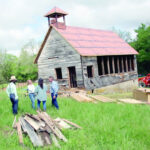For the first half of the 20th century, tomato canning was an important industry Barry County.
During the industry’s peak during the 1930s, a total of 16 canning factories were in operation in Barry County. In 1937 an estimated 2,000 acres of tomatoes were harvested from the county, giving farmers about $50 an acre in extra income during the great depression.
In that same year, approximately 1,200 residents of Barry County were employed from four to eight weeks during the summer and fall. The workers were mostly women, peeling and cooking of the locally grown tomatoes. It was one of the few opportunities for women to work in the Ozarks during that time period, if only for a little while.
The start of the tomato boom in Barry County began about 1903, when the Jenkins canning factory reported producing 100,000 cans of tomatoes. The Exeter canning factory was incorporated in 1903. That same year, the Purdy canning factory claimed a capacity of 10,000 cans per day.
However, the newspaper stated that 16 of the 20 peelers at the Purdy factory went on strike, feeling that 2 cents a bucket was insufficient pay, instead demanding 3 cents per bucket of tomatoes.
The canning factory then replaced the striking girls with boys at a rate of 2-1/2 cents per bucket. A good peeler could make their way through 15-25 scalding buckets a day.
In 1904, a factory was built in Cassville on the east side of Flat Creek across from the mill located on 7th Street. The following years would see canning factories constructed at Monett, Pleasant Ridge, White Oak, Washburn, Ridgley, Wayne, Seligman, Big Springs, Pioneer, Shell Knob, Wheaton, New Hope, Butterfield, Corsicana, Tom Town, Mineral Springs and Cato — pretty much the whole of Barry County and the neighboring counties were full of canning factories at one point.
In 1924, there were 250 canning factories in the Ozarks producing around $4 million in economic value ($70 million in 2023 dollars), the fifth largest industry in the Ozarks during the 1920s and the fourth largest tomato district in the nation, all from being non-existent two decades previous.
In 1925, Cassville shipped 14 train car loads of tomatoes worth about $25,000 (close to $500,000 in today’s terms).
Other varieties of fruits and vegetables were canned from time to time, including green beans, apples, peaches and blackberries, but none seemed to be as profitable as tomatoes. Although nobody got rich canning tomatoes, they did get by.
During the 1940s, some of the factories were outfitted with modern boilers and expanded. Rush Canning Company owned multiple factories in the area during the 1930s and 1940s in Cassville, Washburn, Butterfield and Ridgley, as well as at Bethpage and Garfield in the neighboring counties.
But, by the end of the 1950s, virtually all the tomato canneries had closed. World War II caused a labor shortage during the 1940s. Many of the youth involved in the picking and processing of tomatoes were now involved in the war effort.
Many preferred the permanent work in the factories of Wichita and Tulsa rather than the seasonal work the tomato factories provided. Farmers switched to raising broilers and beef cattle, creating tomato supply issues.
Additionally, large chain grocery chains forced the small suppliers out of business. Modern methods of mechanical harvesting and economies of scale spelled the end of small canning factories in the Ozarks.
Though the season for tomato canning factories ended in the Ozarks, the 1960s would bring fashion season with the coming of Vaisey-Bristol’s Jumping Jacks shoe factories in Cassville and Monett, and now that season too has ended.
But, there always seems to be another season, and that’s probably all an Ozarker really want anyways, to get by in whatever season comes next.
Jeremiah Buntin is a historian at the Barry County Museum.
He may be reached at jbuntin@ barrycomuseum.org.








Both my grandmother and Uncle (Ava and Kenneth Davidson) worked in the Wheaton canning factory in the 1940’s. They referred to the tomato cannery as the “cannin’ factory”. To me, as a child, I thought they worked in a factory that produced cannons… it was, after all, during the second world war, and many people were working in armament factories. However, not in Wheaton.
My grandpa Frank Snyder built tomato crates at his shop in Cassville in the early fourties’